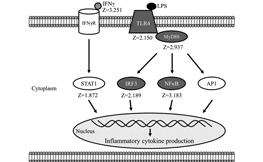This study demonstrated that feeding dietary forage alleviates subacute ruminal acidosis due to diurnal changes in ruminal pH. Read
Effects of ruminal pH on gene expression in the rumen epithelium, peripheral blood 4 mononuclear cell subpopulations, and blood metabolites from Holstein calves during 5 weaning transition
In this 2019 paper published in The Journal of Veterinary Medical Science, the authors found feeding the only starter to calves decreases rumen pH at weaning with upregulation of the receptor TLR4. Feeding only starter lowered cholesterol synthesis in the rumen epithelium whereas starter and forage combined resulted in higher energy status. Read
The genomic and proteomic landscape of the rumen microbiome revealed by comprehensive genome-resolved metagenomics
This work offers a comprehensive analysis of more than 6.5 terabytes of Illumina and Nanopore sequence data, including assembly of 4,941 metagenome-assembled genomes, whole-chromosome assemblies of novel rumen bacteria. Read
Composition of Rumen Bacterial Community in Dairy Cows With Different Levels of Somatic Cell Counts
This research suggests that specific rumen microbes are altered in cows with high SCCs. Cows with high SCCs showed lowered milk and component yield and rumen volatile fatty acids concentration — but these cows also had higher rumen bacterial diversity compared to low SCC cows. Read
Exploring the bovine rumen bacterial community from birth to adulthood
The authors of this 2013 Nature publication describe the changes occurring in the rumen ecosystem after birth. Read
Assembly of 913 microbial genomes from metagenomic sequencing of the cow rumen
This article presents 913 draft bacterial and archaeal genomes from 43 Scottish cattle. Most of these genomes were previously unsequenced strains and species. Read
Changes in the rumen and colon microbiota and effects of live yeast dietary supplementation during the transition from the dry period to lactation of dairy cows
In this study, researchers made innovative use of endoscopy to sample rumen and colon tissues. This technique offered a unique perspective to study rumen microbiota. The resulting research details the effect of the rumen-specific yeast S. cerevisiae CNCM I-1077 on microbiota changes in both rumen and colon around transition. Read
Host-rumen microbe interactions may be leveraged to improve the productivity of dairy cows
In the future, we may be able to estimate dairy production using a “genotype × environment × microbial” interaction model that accurately combines all factors affecting milk production. Read
Page 1 of 2









